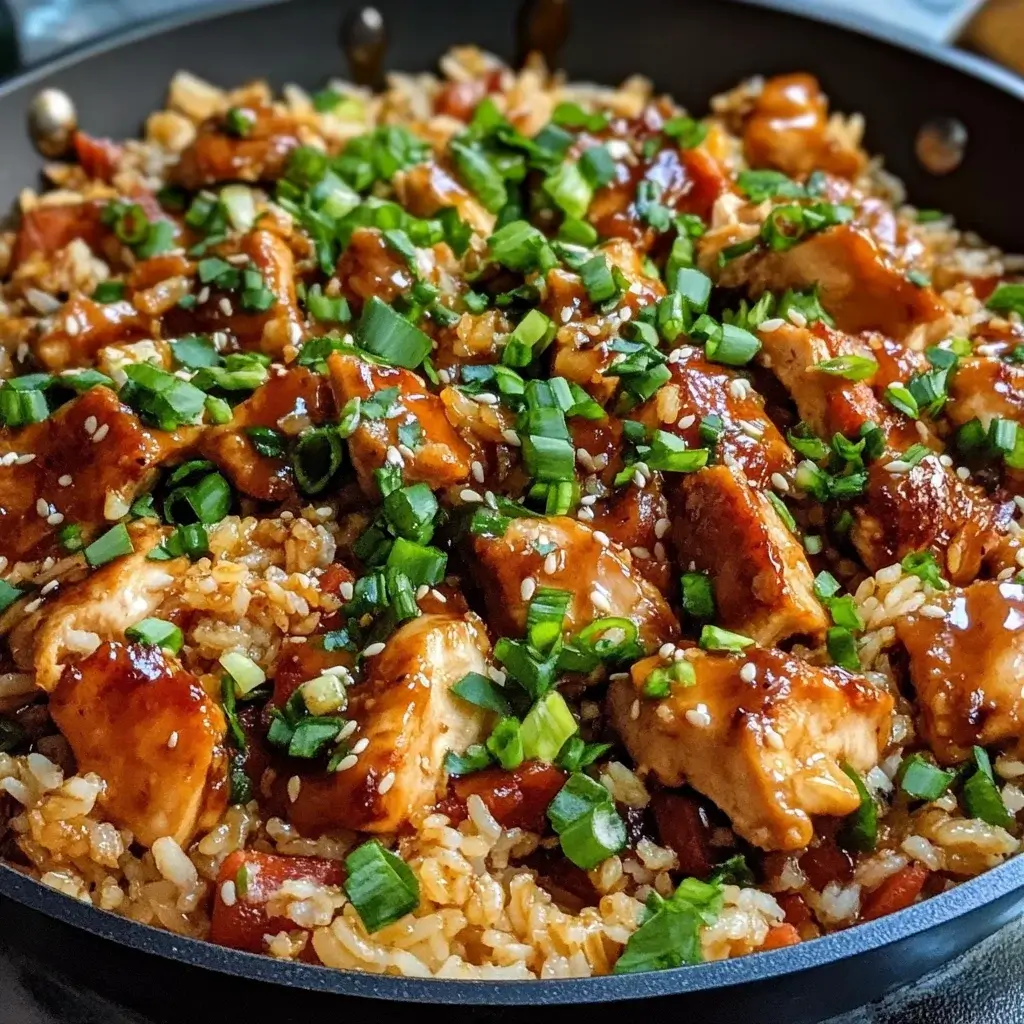This Teriyaki Chicken and Rice Skillet has become an absolute lifesaver in our household. I remember the first time I made it; I was short on time, staring into the fridge, wondering how I could possibly whip up something that everyone, from my picky eater to my perpetually hungry teenager, would actually enjoy. Skepticism was high, especially when I announced it was a “one-skillet meal.” But the aroma that filled the kitchen as the teriyaki sauce simmered and glazed the chicken was the first hint that this might be a winner. And a winner it was! The chicken was tender and juicy, coated in that perfectly balanced sweet and savory sauce, the rice was fluffy and had absorbed all those incredible flavors, and the crisp-tender veggies added a lovely freshness and crunch. Clean plates all around and requests for “when can we have this again?” sealed the deal. It’s now a staple in our weekly rotation, a testament to its deliciousness and incredible ease.
Ingredients
- For the Teriyaki Sauce:
- 1/2 cup low-sodium soy sauce: The salty, umami base of our sauce. Low sodium helps control the saltiness.
- 1/4 cup water: Helps to balance the sauce consistency.
- 1/4 cup mirin (Japanese sweet rice wine): Adds a unique sweetness and gloss. If unavailable, use rice vinegar with an extra teaspoon of sugar.
- 2 tablespoons brown sugar, packed: Provides a deep, molasses-like sweetness. Honey or maple syrup can be substituted.
- 1 tablespoon rice vinegar: Adds a tangy counterpoint to the sweetness.
- 2 cloves garlic, minced: Aromatic powerhouse, essential for flavor.
- 1 tablespoon fresh ginger, grated: Adds a warm, zesty kick.
- 1 tablespoon cornstarch: To thicken the sauce to a beautiful glaze.
- 2 tablespoons cold water: To mix with the cornstarch for a slurry, preventing lumps.
- For the Chicken and Rice Skillet:
- 1.5 lbs boneless, skinless chicken thighs, cut into 1-inch pieces: Thighs are recommended for their flavor and moisture, but chicken breast can also be used.
- 1 tablespoon sesame oil: Adds a nutty aroma and flavor for searing the chicken.
- 1 tablespoon olive oil or vegetable oil: For cooking; can be adjusted based on skillet needs.
- 1 medium onion, chopped: Forms a flavorful base.
- 2 cups broccoli florets: Adds color, nutrients, and a lovely crunch.
- 1 large carrot, peeled and julienned or thinly sliced: Provides sweetness and texture.
- 1 red bell pepper, cored, seeded, and sliced: Adds sweetness and vibrant color.
- 1 cup uncooked long-grain white rice, rinsed: Rinsing removes excess starch for fluffier rice. Jasmine or Basmati work well.
- 2 cups chicken broth (low sodium preferred): The cooking liquid for the rice, infusing it with flavor.
- Optional garnishes: Toasted sesame seeds, sliced green onions.
Instructions
- Prepare the Teriyaki Sauce: In a small bowl, whisk together the soy sauce, 1/4 cup water, mirin, brown sugar, rice vinegar, minced garlic, and grated ginger. In a separate tiny bowl, mix the cornstarch with 2 tablespoons of cold water to create a smooth slurry. Set both aside.
- Sear the Chicken: Heat the sesame oil and olive oil in a large, deep skillet or Dutch oven with a lid over medium-high heat. Once the oil is shimmering, add the chicken pieces in a single layer (work in batches if necessary to avoid overcrowding). Cook for 3-4 minutes per side, until nicely browned but not necessarily cooked through. Remove the chicken from the skillet and set aside on a plate.
- Sauté Aromatics and Vegetables: To the same skillet, add the chopped onion and cook over medium heat for 2-3 minutes, until softened. Add the julienned carrots and sliced red bell pepper. Sauté for another 4-5 minutes, until they begin to soften but are still slightly crisp. Add the broccoli florets and cook for an additional 2 minutes.
- Toast and Cook the Rice: Push the vegetables to one side of the skillet. Add the rinsed rice to the empty space and toast for 1-2 minutes, stirring frequently, until the grains are slightly translucent at the edges. This enhances the nutty flavor of the rice.
- Combine and Simmer: Pour the chicken broth over the rice and vegetables. Stir everything together gently. Bring the mixture to a gentle simmer.
- Return Chicken and Cook: Nestle the seared chicken pieces (and any accumulated juices from the plate) into the rice mixture. Ensure the rice is mostly submerged in the liquid. Once the liquid returns to a simmer, reduce the heat to low, cover the skillet tightly with a lid, and cook for 15-20 minutes, or until the rice is tender and most of the liquid has been absorbed. Avoid lifting the lid during this time to allow the steam to cook the rice properly.
- Add Teriyaki Sauce: Once the rice is cooked, uncover the skillet. Give the teriyaki sauce mixture (without the cornstarch slurry yet) a quick whisk and pour it evenly over the chicken and rice. Stir gently to combine.
- Thicken the Sauce: Bring the mixture to a gentle simmer. Whisk the cornstarch slurry again and pour it into the skillet. Stir continuously for 1-2 minutes, until the sauce thickens to a glossy glaze that coats the chicken and rice beautifully.
- Rest and Serve: Remove the skillet from the heat. If desired, let it rest for 5 minutes, covered, to allow the flavors to meld further. Garnish with toasted sesame seeds and sliced green onions before serving.
Nutrition Facts
- Servings: 4-6 servings
- Calories per serving (approximate): 480-550 kcal (This can vary based on exact ingredient portions, chicken cut, and oil used.)
- Protein: High in protein (approx. 35-40g per serving), primarily from the chicken, crucial for muscle repair, growth, and satiety.
- Carbohydrates: A good source of carbohydrates (approx. 50-60g per serving) from the rice and vegetables, providing energy. The brown sugar in the sauce also contributes to this.
- Sodium: Can be moderate to high (approx. 800-1200mg per serving) due to soy sauce. Using low-sodium soy sauce and broth helps manage this.
- Fiber: Contains a decent amount of dietary fiber (approx. 4-6g per serving) from the vegetables (broccoli, carrots, bell pepper), aiding digestion and promoting fullness.
- Fat: Moderate fat content (approx. 15-20g per serving), mostly from the chicken thighs and cooking oils. Choosing lean chicken breast can reduce this.
(Note: These are estimates. For precise nutritional information, it’s recommended to use a recipe nutrition calculator with your specific ingredient brands and quantities.)
Preparation Time
- Chopping and Prep Time: Approximately 20-25 minutes. This includes chopping vegetables, dicing chicken, measuring out sauce ingredients, and rinsing rice. Efficient mise en place (getting all ingredients prepped before cooking) is key.
- Cook Time: Approximately 35-45 minutes. This encompasses searing the chicken, sautéing vegetables, toasting rice, simmering the rice with chicken, and finally thickening the sauce.
- Total Time: Approximately 55-70 minutes from start to finish. While this might seem like over an hour, much of the cook time is hands-off simmering, allowing you to attend to other things. This makes it a manageable and incredibly rewarding weeknight dinner option that brings a complete meal to the table in one skillet.
How to Serve
This Teriyaki Chicken and Rice Skillet is a fantastic all-in-one meal, but here are some ideas to elevate its presentation and enjoyment:
- Directly from the Skillet: For a rustic, family-style meal, simply place the hot skillet (on a trivet!) in the center of the table and let everyone serve themselves. This minimizes cleanup and keeps the food warm.
- Individual Bowls or Plates:
- Spoon a generous portion of the chicken, rice, and vegetables into individual shallow bowls or onto plates.
- Ensure each serving gets a good mix of chicken, rice, and plenty of colorful vegetables.
- Garnishes are Key:
- Toasted Sesame Seeds: Sprinkle generously over the top for a nutty crunch and visual appeal. To toast, simply heat them in a dry skillet over medium heat for a few minutes until fragrant and lightly golden.
- Sliced Green Onions (Scallions): Add a fresh, mild oniony bite and a pop of green color. Use both the white and green parts.
- Fresh Cilantro or Parsley: If you enjoy these herbs, a little chopped cilantro can add a bright, citrusy note, while parsley offers a clean freshness.
- A Drizzle of Sriracha or Chili Garlic Sauce: For those who like a bit of heat, a small drizzle on top can add an extra kick.
- Simple Side Accompaniments (Optional):
- Steamed Edamame: Lightly salted edamame in the pod makes a great appetizer or simple side.
- Quick Cucumber Salad: A refreshing, lightly dressed cucumber salad (with rice vinegar, a touch of sugar, and sesame seeds) can provide a cool contrast.
- Pickled Ginger (Gari): Often served with sushi, a small amount can cleanse the palate between bites.
- Drink Pairings:
- Japanese Green Tea (Sencha or Genmaicha): A classic pairing that complements the flavors beautifully.
- Sake (Nihonshu): A crisp, dry sake can enhance the umami notes of the dish.
- Light Lager or Pilsner Beer: The crispness of these beers cuts through the richness of the teriyaki sauce.
- Off-Dry Riesling or Gewürztraminer Wine: The slight sweetness and aromatic profile of these white wines can pair nicely with the teriyaki flavors.
Additional Tips
- Don’t Overcrowd the Pan When Searing Chicken: For that beautiful golden-brown crust on your chicken, it’s crucial to sear it in batches if your skillet isn’t large enough. Overcrowding steams the chicken instead of searing it, resulting in a less appealing texture and color.
- Customize Your Vegetables: This recipe is incredibly versatile. Feel free to swap or add vegetables based on what you have on hand or prefer. Snap peas, snow peas, mushrooms, zucchini, bok choy, or even edamame (shelled) would be delicious additions. Adjust cooking times based on the vegetable’s tenderness.
- Homemade Teriyaki Sauce is Worth It (But Store-Bought is Okay): While making your own teriyaki sauce as per the recipe gives you control over sweetness, saltiness, and ingredients (no high-fructose corn syrup!), a good quality store-bought teriyaki sauce can be used in a pinch. If using store-bought, you might not need the cornstarch slurry if it’s already thick, or you might want to taste and adjust (e.g., add a bit of ginger or garlic).
- Rice Rinsing – Don’t Skip It: Rinsing your long-grain white rice under cold water until the water runs mostly clear removes excess surface starch. This step is vital for achieving fluffy, separate grains of rice rather than a sticky, clumpy mess.
- Control the Spice Level: If you like a bit of heat, add 1/4 to 1/2 teaspoon of red pepper flakes along with the garlic and ginger, or a squirt of sriracha into the teriyaki sauce. You can also serve with hot sauce on the side for individuals to customize.
- Marinate the Chicken for Extra Flavor: If you have an extra 15-30 minutes (or even a few hours), marinate the cut chicken pieces in about 1/4 cup of the prepared teriyaki sauce (before adding the cornstarch slurry to the main sauce batch). This allows the flavors to penetrate the chicken more deeply.
- Use Chicken Thighs for Best Results: Boneless, skinless chicken thighs are more forgiving than chicken breasts and tend to stay juicier and more flavorful during cooking, especially in a one-skillet dish where they simmer with the rice. If you use chicken breast, be careful not to overcook it.
- Storage and Reheating: Leftovers can be stored in an airtight container in the refrigerator for up to 3-4 days. To reheat, you can microwave individual portions or gently reheat in a skillet over medium-low heat, adding a tablespoon or two of water or broth to help rehydrate the rice and prevent sticking.
FAQ Section
Q1: Can I use chicken breast instead of chicken thighs?
A1: Absolutely! Boneless, skinless chicken breast is a leaner option and works well. Cut it into similar 1-inch pieces. Be mindful that chicken breast cooks faster and can dry out more easily than thighs. Ensure you don’t overcook it during the initial searing and it should be fine as it finishes cooking with the rice. You might also consider adding it slightly later in the simmering process if you’re concerned.
Q2: What if I don’t have mirin? What are good substitutes?
A2: Mirin adds a specific type of sweetness and gloss. If you don’t have it, you can substitute with dry sherry or a sweet marsala wine in equal amounts. Another common substitute is to use rice vinegar (the same amount as mirin called for) and add an extra 1/2 to 1 teaspoon of sugar per tablespoon of mirin to compensate for the sweetness.
Q3: Can I make this recipe gluten-free?
A3: Yes, easily! The primary source of gluten is the soy sauce. Simply replace the regular soy sauce with an equal amount of tamari (which is typically gluten-free, but always check the label) or a gluten-free soy sauce alternative. Ensure your chicken broth is also certified gluten-free.
Q4: How do I prevent the rice from becoming mushy or sticky?
A4: There are a few key steps: First, rinse the rice thoroughly under cold water until the water runs mostly clear. This removes excess starch. Second, use the correct rice-to-liquid ratio (typically 1 cup rice to 2 cups liquid for long-grain white rice cooked on the stovetop, adjusted slightly for one-skillet meals). Third, once the rice is simmering, cover the skillet tightly and resist the urge to lift the lid and stir. Let the steam do its work. Finally, after the cooking time, let it rest off the heat, covered, for 5 minutes to allow the moisture to distribute evenly.
Q5: Can I use brown rice instead of white rice?
A5: Yes, you can use brown rice for a healthier, higher-fiber option. However, brown rice takes significantly longer to cook (around 40-45 minutes or more) and may require more liquid. You would need to adjust the recipe accordingly: increase the chicken broth by about 1/2 cup and extend the simmering time until the brown rice is tender. You might need to add the chicken and vegetables later in the cooking process to prevent them from overcooking.
Q6: Is this Teriyaki Chicken and Rice Skillet good for meal prepping?
A6: Yes, it’s excellent for meal prep! Cook the entire dish as directed, then allow it to cool completely. Portion it into individual airtight containers. It will keep well in the refrigerator for 3-4 days. Reheat in the microwave or on the stovetop with a splash of water or broth to refresh.
Q7: My teriyaki sauce didn’t thicken enough. What went wrong?
A7: This usually happens if the cornstarch slurry wasn’t cooked enough or if the ratio was off. Ensure you bring the sauce to a gentle simmer after adding the cornstarch slurry and continue to stir and cook for a full 1-2 minutes. The heat activates the cornstarch’s thickening properties. If it’s still too thin, you can mix another teaspoon of cornstarch with a tablespoon of cold water and stir it into the simmering sauce, cooking for another minute.
Q8: Can I use different proteins other than chicken?
A8: Certainly! This recipe is quite adaptable.
* Beef: Thinly sliced sirloin or flank steak would be delicious. Sear it quickly and add it back towards the end to avoid overcooking.
* Shrimp: Add peeled and deveined shrimp during the last 5-7 minutes of the rice cooking, or sauté them separately and stir them in with the sauce.
* Pork: Pork tenderloin, cut into medallions or cubes, would work well.
* Tofu/Tempeh (for a vegetarian option): Press extra-firm tofu, cube it, and pan-fry or bake it until golden before adding it to the skillet. Tempeh can be crumbled or cubed and sautéed. You’d also substitute vegetable broth for chicken broth.

Teriyaki Chicken and Rice Skillet
Ingredients
- For the Teriyaki Sauce:
- 1/2 cup low-sodium soy sauce: The salty, umami base of our sauce. Low sodium helps control the saltiness.
- 1/4 cup water: Helps to balance the sauce consistency.
- 1/4 cup mirin (Japanese sweet rice wine): Adds a unique sweetness and gloss. If unavailable, use rice vinegar with an extra teaspoon of sugar.
- 2 tablespoons brown sugar, packed: Provides a deep, molasses-like sweetness. Honey or maple syrup can be substituted.
- 1 tablespoon rice vinegar: Adds a tangy counterpoint to the sweetness.
- 2 cloves garlic, minced: Aromatic powerhouse, essential for flavor.
- 1 tablespoon fresh ginger, grated: Adds a warm, zesty kick.
- 1 tablespoon cornstarch: To thicken the sauce to a beautiful glaze.
- 2 tablespoons cold water: To mix with the cornstarch for a slurry, preventing lumps.
- For the Chicken and Rice Skillet:
- 1.5 lbs boneless, skinless chicken thighs, cut into 1-inch pieces: Thighs are recommended for their flavor and moisture, but chicken breast can also be used.
- 1 tablespoon sesame oil: Adds a nutty aroma and flavor for searing the chicken.
- 1 tablespoon olive oil or vegetable oil: For cooking; can be adjusted based on skillet needs.
- 1 medium onion, chopped: Forms a flavorful base.
- 2 cups broccoli florets: Adds color, nutrients, and a lovely crunch.
- 1 large carrot, peeled and julienned or thinly sliced: Provides sweetness and texture.
- 1 red bell pepper, cored, seeded, and sliced: Adds sweetness and vibrant color.
- 1 cup uncooked long-grain white rice, rinsed: Rinsing removes excess starch for fluffier rice. Jasmine or Basmati work well.
- 2 cups chicken broth (low sodium preferred): The cooking liquid for the rice, infusing it with flavor.
- Optional garnishes: Toasted sesame seeds, sliced green onions.
Instructions
- Prepare the Teriyaki Sauce: In a small bowl, whisk together the soy sauce, 1/4 cup water, mirin, brown sugar, rice vinegar, minced garlic, and grated ginger. In a separate tiny bowl, mix the cornstarch with 2 tablespoons of cold water to create a smooth slurry. Set both aside.
- Sear the Chicken: Heat the sesame oil and olive oil in a large, deep skillet or Dutch oven with a lid over medium-high heat. Once the oil is shimmering, add the chicken pieces in a single layer (work in batches if necessary to avoid overcrowding). Cook for 3-4 minutes per side, until nicely browned but not necessarily cooked through. Remove the chicken from the skillet and set aside on a plate.
- Sauté Aromatics and Vegetables: To the same skillet, add the chopped onion and cook over medium heat for 2-3 minutes, until softened. Add the julienned carrots and sliced red bell pepper. Sauté for another 4-5 minutes, until they begin to soften but are still slightly crisp. Add the broccoli florets and cook for an additional 2 minutes.
- Toast and Cook the Rice: Push the vegetables to one side of the skillet. Add the rinsed rice to the empty space and toast for 1-2 minutes, stirring frequently, until the grains are slightly translucent at the edges. This enhances the nutty flavor of the rice.
- Combine and Simmer: Pour the chicken broth over the rice and vegetables. Stir everything together gently. Bring the mixture to a gentle simmer.
- Return Chicken and Cook: Nestle the seared chicken pieces (and any accumulated juices from the plate) into the rice mixture. Ensure the rice is mostly submerged in the liquid. Once the liquid returns to a simmer, reduce the heat to low, cover the skillet tightly with a lid, and cook for 15-20 minutes, or until the rice is tender and most of the liquid has been absorbed. Avoid lifting the lid during this time to allow the steam to cook the rice properly.
- Add Teriyaki Sauce: Once the rice is cooked, uncover the skillet. Give the teriyaki sauce mixture (without the cornstarch slurry yet) a quick whisk and pour it evenly over the chicken and rice. Stir gently to combine.
- Thicken the Sauce: Bring the mixture to a gentle simmer. Whisk the cornstarch slurry again and pour it into the skillet. Stir continuously for 1-2 minutes, until the sauce thickens to a glossy glaze that coats the chicken and rice beautifully.
- Rest and Serve: Remove the skillet from the heat. If desired, let it rest for 5 minutes, covered, to allow the flavors to meld further. Garnish with toasted sesame seeds and sliced green onions before serving.
Nutrition
- Serving Size: one normal portion
- Calories: 550
- Sodium: 1200mg
- Fat: 20g
- Carbohydrates: 60g
- Fiber: 6g
- Protein: 40g






